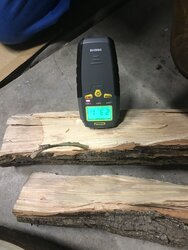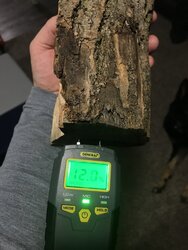Hello Everyone,.... HELP !!
-Jotul F55 Carrabassett 2020 with ReBurn tech non cat
-20ft flue, no damper, double wall insulated flue
-Rutland magnetic stove top thermometer
I'm new to operating a wood stove. My wife and I settled on the Jotul F55 as we have a 2000 sqft home and look to heat it throughout the cold spells of winter with this stove. I competed the break in process, very carefully and slowly. I've begun to burn (well try to anyway! ) at operating temp (500 - 600 deg F) i will admit, I have been very timid to load up the stove. I've been reading all day on these threads and i believe I've definitely found some of my mistakes, but I feel like I'm still doing some things wrong. Im burning Birch with a few Ash mixed in the lot at times. I'm still waiting for my cords of ash and oak to fully season and then i will move away from birch.
Like I said I've been very timid, and haven't been able to get the temp beyond 350 and active flames for more than an hour until tonight. I was initially loading 2 to 4 logs at a time and as they burned down, adding 1 to 2 more at a time.
After researching today, I finally grew the gonads and loaded 8 splits in at once, decent size splits, i would say i filled the stove a little more than 1/3. This was on a bed of hot coals.
I had bypass wide open for about 5 minutes until flames were full and all splits caught. Then lowered to half, and after a few minutes of rolling fire, my temp was 500 deg, re-burners in full swing, and consistent flames from the splits. At this point i closed the bypass completely.
This lasted about 45 minutes until it really started to die down, temp dropped to about 450-475, and slowly dropped from there. At an hour and a half, stove was at 400 and there were large remnants of splits, smoldering, some with very short blue flames emerging. The room has begun to cool and the temp is 300 after 2 hours, still large smoldering with small blue flames.
When the fire began to die down, i tried to open the bypass a little more but this did not seem to help.
2 hours in, after loading 8 splits, my stove top temp is 300.
Thank you in advance, i look forward to any advice, criticisms, and knowledge you are willing to share.
Regards,
Matt
-Jotul F55 Carrabassett 2020 with ReBurn tech non cat
-20ft flue, no damper, double wall insulated flue
-Rutland magnetic stove top thermometer
I'm new to operating a wood stove. My wife and I settled on the Jotul F55 as we have a 2000 sqft home and look to heat it throughout the cold spells of winter with this stove. I competed the break in process, very carefully and slowly. I've begun to burn (well try to anyway! ) at operating temp (500 - 600 deg F) i will admit, I have been very timid to load up the stove. I've been reading all day on these threads and i believe I've definitely found some of my mistakes, but I feel like I'm still doing some things wrong. Im burning Birch with a few Ash mixed in the lot at times. I'm still waiting for my cords of ash and oak to fully season and then i will move away from birch.
Like I said I've been very timid, and haven't been able to get the temp beyond 350 and active flames for more than an hour until tonight. I was initially loading 2 to 4 logs at a time and as they burned down, adding 1 to 2 more at a time.
After researching today, I finally grew the gonads and loaded 8 splits in at once, decent size splits, i would say i filled the stove a little more than 1/3. This was on a bed of hot coals.
I had bypass wide open for about 5 minutes until flames were full and all splits caught. Then lowered to half, and after a few minutes of rolling fire, my temp was 500 deg, re-burners in full swing, and consistent flames from the splits. At this point i closed the bypass completely.
This lasted about 45 minutes until it really started to die down, temp dropped to about 450-475, and slowly dropped from there. At an hour and a half, stove was at 400 and there were large remnants of splits, smoldering, some with very short blue flames emerging. The room has begun to cool and the temp is 300 after 2 hours, still large smoldering with small blue flames.
When the fire began to die down, i tried to open the bypass a little more but this did not seem to help.
2 hours in, after loading 8 splits, my stove top temp is 300.
Thank you in advance, i look forward to any advice, criticisms, and knowledge you are willing to share.
Regards,
Matt




 ! Not a ton of heat, stove top says 350, but this is the longest burn I've had yet (i mean burn time with actual flames) and there is still at least 50% of each split left. There are almost transparent flames throughout. Now I'm getting encouraged! However, I'm still going to beat around the idea that this thermometer is junk. How can the stove top possibly only be 350deg!? I refuse to believe this thing is accurate...
! Not a ton of heat, stove top says 350, but this is the longest burn I've had yet (i mean burn time with actual flames) and there is still at least 50% of each split left. There are almost transparent flames throughout. Now I'm getting encouraged! However, I'm still going to beat around the idea that this thermometer is junk. How can the stove top possibly only be 350deg!? I refuse to believe this thing is accurate...